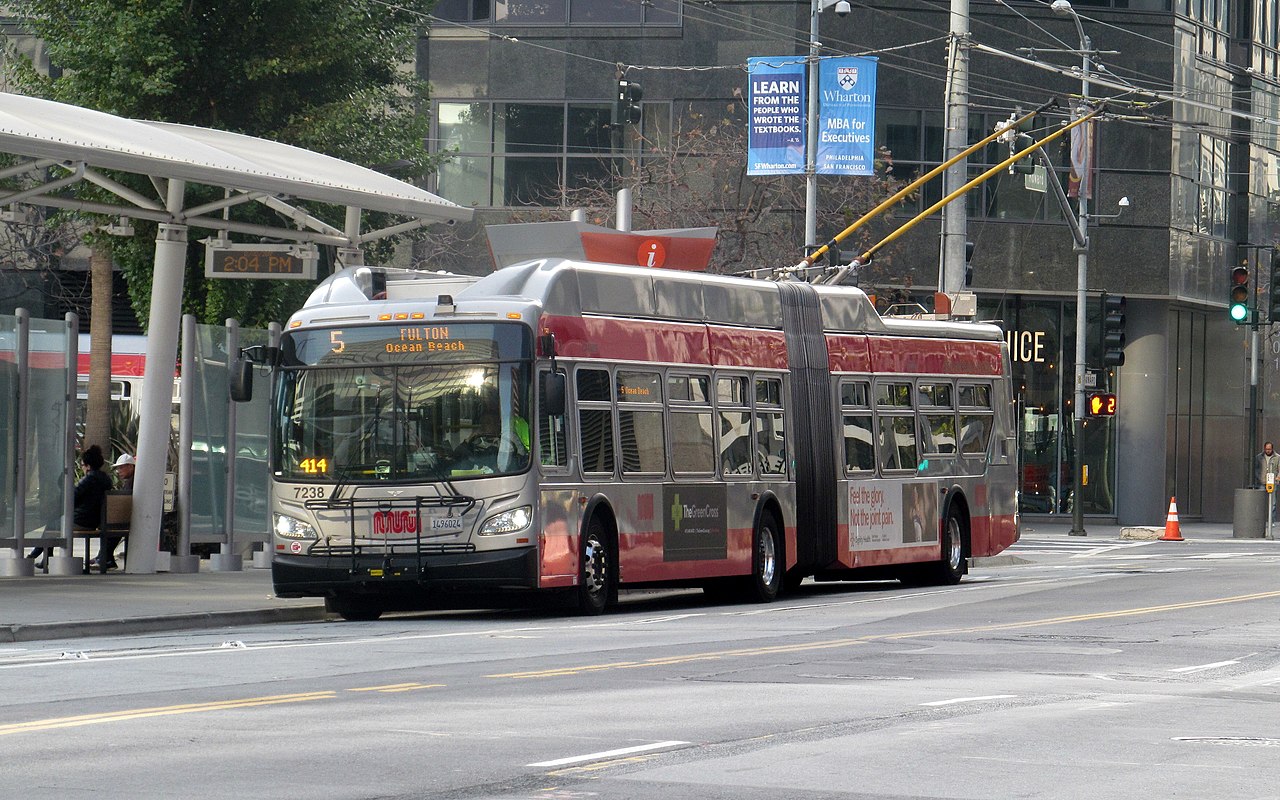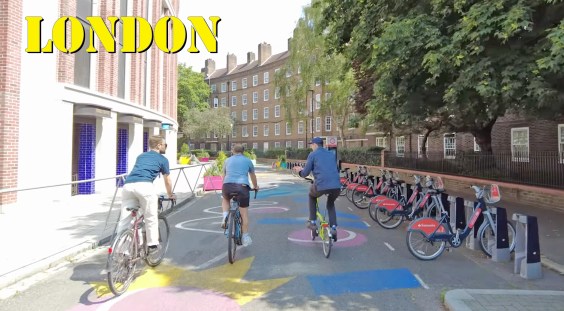 Toronto's Post and Ring solution for bicycle parking on old parking meter poles. Photo: David Baker
Toronto's Post and Ring solution for bicycle parking on old parking meter poles. Photo: David BakerWhen Oakland installed its first pay-and-display parking kiosks in early 2007, parking managers ordered employees to remove the heads of the approximately 5,000 single-space meters they were replacing. Just like other cities transitioning from using single-space parking meters
to newer multi-space pay stations, the
parking managers failed to realize the utility of those old meter poles
for cyclists, who used them for locking up their bicycles.
"This was the last breath of turning your back on cyclists. It was
obscene," said East Bay Bicycle Coalition (EBBC) Executive Director Robert Raburn, who
admitted that they weren't prepared for the change and the effect it
would have on cyclists, so their advocacy was "reactionary."
The EBBC lobbied the Oakland City Council to retain what meters they could after the process had started. "What we were asking for was to make sure there was
some integration between the installation of parking kiosks and bike
parking," said Raburn
Jason Patton, Oakland's Bicycle and Pedestrian Program Manager, said
that the initial problem stemmed from the fact that two divisions of
two separate agencies within the city weren't on the same page about
bicycle parking and so the provisional solution was the best they could
do.
"The plan for the new parking stations didn't
address bicycle parking. Really the only option we had in working on
their timeline was to leave
meter heads," said Patton.
Over the complaints of the parking division, the EBBC worked with Oakland's bicycle program to develop an interim policy of preserving a minimum of two meter heads per block space in the areas where kiosks were installed. The bicycle division then spent a good deal of time and money surveying bicycle use on every street where the meters were being replaced to maximize the benefit to cyclists. Parking managers removed the "guts" of the meter heads so that drivers were less confused and affixed small yellow stickers that remind cyclists to park their bicycles parallel to the curb.
Still, all sides agreed bicycle parking at meter poles is not ideal. "The problem with leaving the head on is that it's confusing and unsightly and often times the pole location is not an ideal place to park bikes," said Raburn. Through sales-tax funding, the EBBC and the Oakland Bicycle Program have collaborated to methodically add bicycle racks on sidewalks in front of businesses, parks, and other destinations frequented by bicyclists.
Toronto, Canada
Oakland's story is very similar to many other cities, though unfortunately it seems that few city managers are sharing best practice examples with each other. Toronto, Canada, was an early adopter of multi-space meters and parking managers there learned quickly how to use the old meter poles for bicycle parking.
Daniel Egan, Manager of Pedestrian and Cycling Infrastructure for the City of Toronto, said the parking managers were on the same page with his division when they began installing multi-space pay stations in early 2001. "Any time they were taking out a parking meter head, we would review them," he said. "Sometimes they were too close to the curb or to other structures, so they were removed."
For every parking meter the parking authority removed it would pay for a retrofit to old posts, what has been dubbed the Post and Ring. The initial metal rings were $40 a piece and were attached to the existing meter pole with large bolts. The complete retrofit cost was about $80 per post if they were keeping the original post, $125 per post if installing a new post.
Egan admitted that the original ring design was not as secure as it should be, so that crafty thieves had figured out how to break them off and remove the entire ring, which they would presumably cut off the bicycle when not in public. "We had a problem a couple of years ago with people breaking them off. So now we put in a double ring, which looks good: two 250 lb guys from our staff couldn't
break it."
Toronto currently has 16,000 of the Post and Ring bicycle parking poles, of which about were 8,000 paid for by the parking authority. "They basically agreed to put a ring on every post in the city," said Egan.
 Los Angeles has affixed a small, decorative top to old meter poles as it transitions to new mult-space pay statinos like the one at left. Photo:LADOT
Los Angeles has affixed a small, decorative top to old meter poles as it transitions to new mult-space pay statinos like the one at left. Photo:LADOTBoth Chicago and Los Angeles are trying out small pilot programs to convert meter posts to bicycle parking, though neither have developed a comprehensive policy to address every meter pole being removed.
In Chicago, the city is leaving one or two poles per block as conversions occur. Chicago Department of Transportation (CDOT) spokesperson Brian Steele said: "Chicago is working with the bike community to identify high-priority parking locations, and continues to explore locations for permanent bike racks--our bike parking program has already installed more than 11,000 racks citywide."
As for meter conversions, he said they started a program this spring to leave one or two meter poles per block face and more in priority locations. When preparing a conversion, CDOT posts information on its Bike Program web site
seeking input from the cycling community. Additionally, they have a full-time student intern who goes to conversion locations to
identify which and how many meter poles to retain for future retrofit
as bike racks.
The policy was put in place this spring and further elaboration of it is a priority of the Chicago Bike 2015 Plan, according to Steele. "We are exploring equipment to retrofit the poles with an attachment to
allow bike parking. We have received samples from at least two
manufacturers and are currently testing them."
In Los Angeles, the city installed 285 new meter heads adjacent to multi-space pay stations two weeks ago, what they call the Meter Hitch Bicycle Rack. The new Meter Hitch racks are in eight neighborhoods along commercial corridors and cost the city $50,000 to install, money which came from sales-tax and property tax increments agreed to in voter initiatives. According to LADOT's primer:
The new bicycle racks take advantage of the work of the Smart MeterParking Pilot Program and re-use existing meter infrastructure toconvert old parking meters to new Bicycle Parking Racks. The BicycleOutreach and Planning staff has worked very closely with the Office ofParking Management and Regulations, the six different city counciloffices affiliated with the installation areas, business improvementdistricts, and local businesses to complete the project.
In New York City, former Department of Transportation (DOT) Commissioner Iris Weinshall embraced multi-space meters in the city's Central Business District, but wasn't so hot on bicycle infrastructure. As a result, much of Manhattan's business districts were converted to the multi-space meters without any consideration of bicycle parking.
When asked if NYCDOT has a policy to convert remaining single-space meters in other business districts in the city that still have them, NYCDOT Senior Policy Advisor Jon Orcutt said, "The ship sailed on that one before anyone looked at the policy. There's not much bike parking left to preserve."
Orcutt said the agency's priority now is installing new bicycle racks as quickly as possible throughout the city. In fiscal year 2008, the agency installed 1,377 racks, up from 320 the year before. They've set a goal to add 5,000 new racks over three years in addition to the current 6,100 racks.
About retrofits, Orcutt admitted the agency didn't do as much as it could have. "We really should have gotten on that five years ago. When we looked at that universe, it didn't make sense to do retrofits. What we need to do is basically catch up with installing new bike racks and we'll try to be sensitive and coordinated with it."
Bicycle advocates are not thrilled with that response, however. "That's one rack for every 31 cyclists. That's completely inadequate," said Caroline Samponaro, Director of Bicycle Advocacy for Transportation Alternatives, who hopes that San Francisco and other cities look at New York to avoid the same issue. "Lack of bicycle parking is one of the biggest deterrents to bicycle riding in this city."
In San Francisco, the MTA is debuting its much heralded SFPark pilot program, which will affect more than 6,000 metered spaces. Though many of those meter poles will lose their heads or be removed completely because the agency doesn't think they are aesthetically pleasing and doesn't want to confuse motorists with pockets full of change, they will keep a number of meter poles for SFPark and simply retrofit the single space meters with radio technology.
MTA spokesperson Judson True said they are committed to providing better bicycle parking than what exists, but that they don't have a policy on meter pole retrofits. "We have all these strategies for bike parking that don't rely on meters. It's not to say we won't have an official policy, but we're not developing one now."
True added that they aren't rushing out to cut off the heads of all the meters. "It's going to be a while before the meters are gone."
True wanted to focus instead on what his agency could do to try more dynamic bicycle parking options, such as converting vehicle parking spaces to bike parking on street, which has been successfully implemented on Grove Street in front of the main branch of the San Francisco Public Library.
Advocates said they have been discussing the issue with the agency for over two years and they've been given assurances that the MTA will not allow a decrease in available bicycle parking citywide. SFBC Executive Director Leah Shahum agreed with True that more innovative parking like bicycle corrals in vehicle spaces is where they would like to focus.
"On-street corrals are the prize," said Shahum, who also noted that cleaning up clutter from sidewalks was important for her group and for pedestrian advocates. "One of the sub goals is to remove clutter from the sidewalk. There's a goal of having more efficient bicycle parking and better parking management, but in terms of the clutter challenge, I think there's not enough consideration to the ramifications on bike parking in the city."
She also said businesses were anxious to convert the vehicle parking spaces in front of their stores to bicycle parking to target their bicycle-riding patrons and maximize the number of customers that could park in the space. "Over a dozen businesses have expressed interest in removing the car space and replacing it with bicycle corrals," she said.





